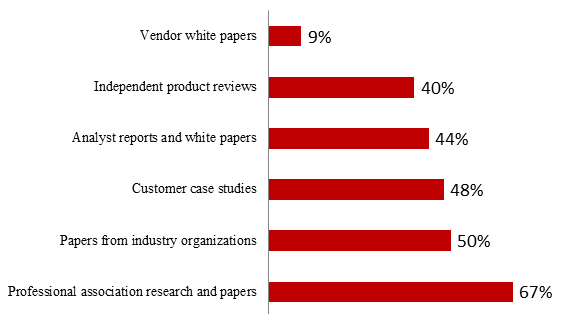
by Fronetics | Aug 19, 2014 | Blog, Content Marketing, Leadership, Marketing, Strategy, Talent

By consistently creating, curating, and distributing valued and trusted content you can position your company as an industry leader.
What is valued and trusted content?
“Peer-power”
A survey by the CMO Council found that all content is not viewed equally by B2B buyers. “Peer-powered content” is more valued and trusted than non-peer content.
The survey found that professional association research and papers are the most valued and trusted content. Papers from industry organizations, case studies, and analyst reports and white papers were also reported to be valued. In contrast, vendor white papers were not found to be valued highly.
What type of content do you most value and trust?

Source: CMO Council
Depth not promotional
The characteristics that were found to be valued the most by B2B buyers were depth of the content (47 percent) and ease of access and readability (44 percent). Respondents reported that they do not like content that has too many requirements to download (50 percent) or is promotional or self-serving (43 percent).
Good content is shared
B2B buyers report that they share good content. Fifty-nine percent of survey respondents share content with 25 or more peers and associates, and 28 percent of survey respondents forward content on to 100 or more people.
Position yourself
To position your company as an industry leader you need to provide valued and trusted content. This means creating, curating, and distributing content that educates, informs, and addresses specific needs.
It also means avoiding the trap of self-promotion. Valued and trusted content is not content that is self-serving or promotional, rather valued and trusted content provides customers with answers, solutions, and education.
Blogging is essential, but additional content is necessary as well. Case studies and white papers are two go-to content solutions that can help you position your company as a trusted leader within your industry.
Remember that you don’t need to go it alone. More than 44 percent of B2B marketers report that they outsource content creation.

by Fronetics | Aug 14, 2014 | Blog, Marketing, Social Media, Strategy, Supply Chain
We want to hear from you! 
We want to know what questions you have about:
- Demand generation
- Establishing and growing an online presence
- Social media
- Content
These categories are intentionally broad because we want to you to think about any (and all) questions and pain points you might have related to these topics.
Remember the adage – there is no stupid question.
Why do we want to hear from you?
We have an upcoming series of blog posts that are focused on answering questions that companies within the supply chain industry have regarding demand generation, an online presence, social media, and content. We want to give you the opportunity to ask your questions and state your challenges so that your questions and challenges can be addressed.
How can you be heard?
Fill out the form below or content with us via Twitter or LinkedIn.

by Fronetics | Aug 14, 2014 | Blog, Marketing, Social Media, Strategy, Supply Chain
We want to hear from you! 
We want to know what questions you have about:
- Demand generation
- Establishing and growing an online presence
- Social media
- Content
These categories are intentionally broad because we want to you to think about any (and all) questions and pain points you might have related to these topics.
Remember the adage – there is no stupid question.
Why do we want to hear from you?
We have an upcoming series of blog posts that are focused on answering questions that companies within the supply chain industry have regarding demand generation, an online presence, social media, and content. We want to give you the opportunity to ask your questions and state your challenges so that your questions and challenges can be addressed.
How can you be heard?
Fill out the form below or content with us via Twitter or LinkedIn.

by Fronetics | Aug 13, 2014 | Blog, Marketing, Social Media, Strategy, Supply Chain
Leads are essential to the growth of your business. Social media is an effective way to find new leads.
Social media allows you to find new leads by doing something called social prospecting. Social prospecting is the art of searching the social web, identifying potential prospects for your business, and engaging them in a manner that draws them to your company’s website and through your funnel.
Social prospecting
At the core, social prospecting is about listening. It is about listening to social media conversations in order to generate leads for your business. It’s beyond monitoring keywords. It’s about engaging people that may or may not know what your business can do for them.
Workbook
We’ve identified the quickest way to find potential prospects on Twitter, Facebook, LinkedIn, Pinterest, and Google+ and compiled them in a workbook. Every worksheet includes: a short preparatory work to make the actual prospecting easy; visual instructions on how and where to find prospects; pro tips that will help you get the best results; prescriptions (Marketing Rx) for success; and take-home exercises for follow-up prospecting
Get started
Want to get started? Simply download the workbook.


by Fronetics | Aug 13, 2014 | Blog, Marketing, Social Media, Strategy, Supply Chain
Leads are essential to the growth of your business. Social media is an effective way to find new leads.
Social media allows you to find new leads by doing something called social prospecting. Social prospecting is the art of searching the social web, identifying potential prospects for your business, and engaging them in a manner that draws them to your company’s website and through your funnel.
Social prospecting
At the core, social prospecting is about listening. It is about listening to social media conversations in order to generate leads for your business. It’s beyond monitoring keywords. It’s about engaging people that may or may not know what your business can do for them.
Workbook
We’ve identified the quickest way to find potential prospects on Twitter, Facebook, LinkedIn, Pinterest, and Google+ and compiled them in a workbook. Every worksheet includes: a short preparatory work to make the actual prospecting easy; visual instructions on how and where to find prospects; pro tips that will help you get the best results; prescriptions (Marketing Rx) for success; and take-home exercises for follow-up prospecting
Get started
Want to get started? Simply download the workbook.


by Fronetics | Aug 6, 2014 | Blog, Logistics, Marketing, Social Media, Strategy, Supply Chain, Transportation & Trucking

Keychain Logistics has made two bold promises. The company has promised truckers that they will never drive empty again and has promised shippers that Keychain will improve their bottom line.
Can the company deliver on these promises?
Who is Keychain Logistics?
Keychain is a leading transportation provider enabling businesses to directly engage carriers, track shipments, and monitor its logistics needs online.
According to Bryan Beshore, the company’s founder, Keychain grew out of the idea that a technology driven marketplace could operate with significantly lower overhead than a manual, human powered brokerage:
“My initial contact with the industry was in 2000. I have researched, analyzed, and thought about the industry ever since. Keychain is a product in understanding the fundamental efficiency problems the third party logistics industry has faced for a long time.”
Beshore goes on to point out that while building a technology company is tough, building Keychain was easier than anticipated:
“With Keychain it was a natural process and easier than I had imagined. I believe the reason for this is twofold: the challenges this industry faces are huge, and the solutions we are building to meet those problems are really fun to solve. Because our work directly affects the wallets of our users (increased pay for drivers, better rates for shippers), we are effectively helping people create better lifestyles for themselves and their families, and that’s really rewarding.”
The company was slated to be built in 2007; however, the timing was not right given the low proliferation of internet-connected mobile devices (500 million). Beshore waited. In 2012 he decided to move forward with the launch of the company (the number of internet connected devices reached 8.7 billion in 2012).
How does it work?
One can draw a parallel between Keychain and Uber – the company removes the broker and connects truckers directly with shippers therefore enabling truckers to focus on driving and shippers to focus on selling products.
Keychain is a marketplace for truckers to book commercial shipments directly with shippers. The company’s technology matches owner operator drivers (and small fleets) with shippers who rely on Keychain Logistics to find the ideal carrier for their freight.
The core of the company’s platform is their network of ten-of-thousands of carriers throughout the US who are connected 24/7/365 via Keychain’s iOS, Android, and Windows phone apps. Keychain can instantly communicate load opportunities to independent owner-operators, 97 percent of whom operate in fleets of 20 trucks or less, and small carrier fleets.
Too good to be true?
One of the biggest challenges the company has faced is that it is perceived as being “too good to be true.” Beshore:
“The transportation industry is traditional and technologically far behind. Because of this, the inherent challenge to sharing our offering is overcoming the “too good to be true” bias. While many of our potential customers have wanted a product like ours for a while, they either don’t know how to articulate it in a Google search or are skeptical that tech companies like Keychain are committed to solving their problems.”
Solving immediate need
Keychain has been working to overcome the perception of being too good to be true. It has been talking to current users, and has honed in on developing a solid marketing message. The message – we can solve your immediate need.
Not expressing the full-vision up front has been a challenge when Keychain reaches out to companies with whom they have little or no relationship; however, they have found that solving an immediate need is what gets companies excited.
What immediate need(s) can the company address? According to Beshore: “For shippers, this is getting them access to trucks, sometimes within just minutes of our first contact. For drivers, this means getting them a paying load when they’re stuck at a rest stop, are far from home, or simply need a line-haul out.”
Leveraging social media to grow the company
The company has found that one of the best ways to use social media is for listening. Rather than spend time and money putting together and distributing sales literature, the company searches for relevant industry hashtags (i.e.: #trucking) to see what people are talking about, and more importantly what they care about. By using social media this way, Keychain is an audience to users instead of the other way around. This has enabled the company to shape their offering with a solid understanding of what people want from a transportation provider.
“From phone calls to interviews, crowdfunded campaign partnerships, and beyond, social media has certainly helped us grow our business,” says Beshore.
Can they deliver?
Can Keychain deliver on their bold promises? Their customers believe so. Here is what three customers say about the company:
“With Keychain I no longer have to waste hours on logistics. Their platform makes it easy to quickly enter shipment details and receive the most competitive rates available.” Marc DeVidts, Double Robotics
“Keychain gives us instant access to thousands of reliable carriers nationwide. It’s the most efficient and cost effective tool we’ve found.” Nathan Brown, Reclaimed American Hardwood
“Within minutes I can enter my shipment details and Keychain handles the rest. Annoying phone calls and exorbitant broker fees are over.” Ad Sachan, Treeline Woodworks.







